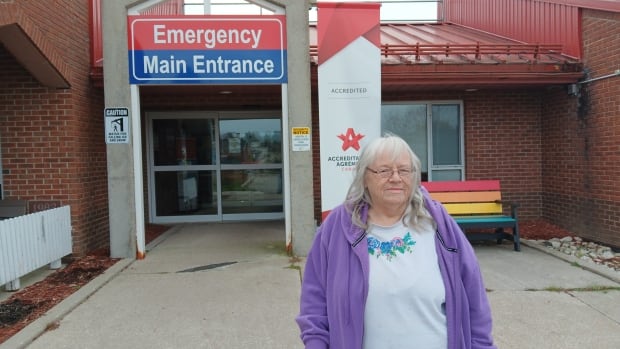Timing was everything for Bruce Pieroway when he suffered a heart attack in late October in the rural farming community of Chesley, Ont., about two hours north of Kitchener.
It happened early on a Monday afternoon when the town’s only emergency room was still open.
“The worst thing about the hospital here is you don’t know whether it’s open or closed,” said Pieroway, referring to Chesley’s ER, which has faced chronic closures since 2022 and now only operates between 7 a.m. and 5 p.m., Monday to Friday.
For Pieroway, who is 70, the next closest emergency department is a 25-minute drive away.
But fortunately, at 2 p.m. that October day, the Chesley ER was open and hospital staff were able to get him stabilized.
Over the past three years, at least 38 Ontario hospitals with emergency rooms or urgent care centres (UCCs) have experienced closures — about one in five of 176 publicly funded facilities.
Most are in rural areas. And Chesley’s ER tops the list with the highest number of hours closed.
That’s according to CBC’s new compilation of all temporary closures and service interruptions announced by ER and UCC departments between Jan. 1, 2022, and Nov. 30, 2024.
CBC’s analysis tracked the hours they were closed and the number of days with a partial closure.
Even though 2024 isn’t over, the data shows this will be the province’s worst year for ER closures, a phenomenon that was “very rare” before 2019-20, according to a report by the Office of the Auditor General of Ontario.
“What it’s meant here is a lot of anxiety from people in the community [and] frustration sometimes boiling over into anger,” said Brenda Scott, co-chair of the Save the Chesley Hospital Committee.
“I’ve always said, you love to be number one, but not in this contest,” she said. “You can feel that tension in the community.”
Since hospital emergency departments are considered 24-hour operations, any disruptions or changes to those hours, either temporary or permanent, were counted as closures in CBC’s analysis.
“What an emergency department is, it’s an access point for 24/7 care for patients of any acuity,” said Dr. David Savage, an ER physician in Thunder Bay. “I think it’s challenging to call a centre an ER if it’s closing during certain parts of the day.”
If a patient shows up to an ER and they’re still waiting at closing time, medical staff tell CBC that they will attend to their care even after locking the doors for the night.
According to CBC’s analysis, unscheduled ER closures have significantly decreased over the past few years — from amounting to nearly 4,200 hours in 2022 to about 939 hours this year.
But some emergency departments, including Chesley’s, have shifted to daytime, office-like hours.
These so-called “scheduled closures” represent more than 93 percent of all service interruptions for ERs in the province so far this year, more than offsetting any improvements in “unscheduled closures.”
“A closure is a closure, whether it’s scheduled or not”, said Savage. “That does limit people’s access to care.”
Savage is one of two emergency doctors, along with a health-care advocate and a nurse association executive, to have gone over CBC’s methodology and findings.
“This really is the worst that it’s ever been. This is not normal, and it should never become a new normal,” said Natalie Mehra, executive director of the Ontario Health Coalition.
That organization has kept its own tally of closures, while a grassroots group called Ghost Gurney maintains a map detailing closures.
For Mehra, formally reducing hours of ER service can’t be the answer.
“That is completely unacceptable and it has to stop. That takes leadership. Literally the minister of health could do that,” Mehra said.

Reduced hours at 6 urgent care centres
2024 also appears to be a record year for closures at UCCs, medical clinics that provide same-day urgent treatment for injuries such as sprains and broken bones and illnesses like fevers.
Several ER physicians tell CBC that while UCCs don’t serve the same functions as ERs, these departments have become a critical access point for many patients in a province where 2.5 million people are without a family doctor.
“I see my colleagues in urgent care doing very emergency medicine-style work,” said Dr. Andrew Park, former president of the Ontario Medical Association and ER physician in St. Thomas, Ont.
“Whether they’re going to emergency departments or urgent care … they’re trying to find access to care that they just simply don’t have.”
CBC data shows that six urgent care departments have reduced regular hours and have been closed for more than 10,000 hours so far this year. Scheduled night-time closures at a handful of centres make up the vast majority, the same trend found with emergency rooms.
The Fort Erie and Port Colborne Urgent Care Centres near Hamilton account for a significant portion of these hours.
CBC also shared its key findings with the Ontario Hospital Association (OHA), including a list of the 10 ERs and UCCs that had the most days with a closure since 2022.
The OHA, which calls itself the voice of Ontario’s public hospitals, stated that CBC had “erroneously included urgent care centres in its analysis of emergency departments”.
“Urgent care centres provide services for those with unexpected but non-life-threatening health concerns that require same-day treatment,” a spokesperson wrote in an email. “In 2023/24 there were more than 350,000 visits to urgent care centres in the province of Ontario.”

‘Great progress’: OHA
OHA president Anthony Dale initially agreed to an interview to discuss the findings but then cancelled, citing “serious concerns” over some of CBC’s methodology, including using the “number of days with a closure” as a unit of measurement.
The OHA said hospitals across the province have made “great progress” when it comes to addressing staffing challenges.
In recent years, the Ontario government has “implemented a range of programs designed to recruit and retain health care workers to encourage practice in rural and remote communities,” reads the OHA statement.
In September, CBC News asked Ontario’s Ministry of Health for ER closure data, but was directed to file a freedom of information request.
Last week, the ministry said in an email that over the last year it had seen “the number of emergency department reduced hours” drop by 84 per cent. They also said there were “a total of 90 reduced hours across the province” from June to August 2023, dropping to “a total of 13” during the same months in 2024.
In an attempt to deal with closures, the province introduced a temporary locum program, essentially providing fill-in doctors from other regions, to staff emergency rooms in rural and northern hospitals.
In July 2023, the Ford government pledged $44 million – in addition to the $90 million invested yearly – specifically to reduce ER wait times, address staffing challenges, and prevent closures.
Nurse shortage top reason for closures
CBC’s data also shows the primary cause of ER closures has been a shortage of nurses, accounting for more than 85 per cent of all closure hours.
“Nurses are leaving the profession. Nurses aren’t entering the profession. They’re not staying in the profession, and I don’t think anyone can blame them when there’s not much to keep us here,” said Erin Ariss, an ER nurse and the president of the Ontario Nurses’ Association.
According to Ariss, rural hospitals have been chronically understaffed for years. As ER wait times grow, staff are too often subjected to violent behaviour, Ariss said, and the resulting stress has led to widespread burnout.
While some hospital CEOs report improvements in nursing recruitment, the reliance on agency nurses — temporary staff contracted through private agencies — is helping keep ERs open at a high cost.
For example, one northeastern Ontario hospital has spent nearly a million dollars on agency nurses this year to maintain emergency services.
“They charge hospitals three or four times the amount of money that it would cost to provide the same unionized nurse,” said Ariss. “You can’t blame the nurse. This is a systems issue.”
On Nov. 20, the province pledged more than $500 million to educate new nurses and provide specialized training to current ones.
Meanwhile, a lack of physicians was the most common factor for service interruptions in UCCs, representing over 69 per cent of all centre closure hours, CBC’s data shows.
Most closures in rural hospitals
The ten ERs closed for the most hours since 2022 are all in rural communities with populations under 8,000, and each facility has fewer than 50 beds.
“You’re impacting people that are already marginalized … making their access to health care more difficult,” said Park.
In fact, the bulk of the ER closures tracked in 2024 are connected to rural hospitals in Chesley, Clinton and Durham, all in southwestern Ontario and all currently closed at night.
At recent public meetings, residents in that region made it clear to Nancy Shaw, CEO of the South Bruce Grey Health Centre, that they want 24/7 emergency services.
Shaw said the dearth of nurses prevents the hospital authority from operating all its ERs full-time.
“We know we can’t provide that right now,” said Shaw. “We have to use agency staff or agency nurses to fill those gaps in our nursing requirements.”
‘Worsening across the country’
This trend of frequent ER closures is not limited to Ontario, with rural hospitals from Nova Scotia to Quebec to British Columbia grappling with the issue.
“The situation is worsening across the country. We are seeing more closures year by year,” said Dr. Aimee Kernick, president of the Canadian Association of Emergency Physicians.
Kernick practices at the Saanich Peninsula Hospital on Vancouver Island. It’s been closed overnight for a year.
Patients have told her they’ve endured chest pain at home because the ER was closed, Kernick said, choosing to wait until it reopened in the morning rather than traveling further to another hospital.
“Without a doubt there will be poor patient outcomes across the country with closures and inaccessibility to care,” said Kernick.
Back in Chesley, Bruce Pieroway had heart surgery in late October and is now recovering well. He hopes he won’t need to visit his local ER again, but if he does, it can still only be during daytime hours.
Mehra, with the Ontario Health Coalition, has travelled the province, talking to residents. She’s also concerned about the potential consequences of closed emergency departments.
“When you’re having a heart attack, are you supposed to be looking up on the internet or phoning around to figure out what emergency department is open? That’s ridiculous,” said Mehra.
Meanwhile, ER physicians like Park wonder what happens to those who don’t seek emergency help because of long waits or closures.
“A lot of times we don’t even hear about the ones that couldn’t get care, because they die at home or they have really bad outcomes,” said Park.
“My hope is that we’re not waiting till people die, till we make these really structural and foundational changes.”
|
METHODOLOGY: How did CBC track ER and UCC closures? This dataset documents every closure of an emergency room and urgent care centre (UCC) reported by one of 176 publicly funded hospital facilities with an ER or a UCC department in Ontario between Jan. 1, 2022 and Nov. 30, 2024. It was compiled and verified by CBC using hospital news releases and documented media reports. CBC defined a closure as any interruption to an ER’s 24-hour service or a UCC’s previously posted hours at any time for any amount of time on a given date. If a facility was closed for several hours twice in a day – for example, in the morning and later at night – the hours were summed up, but it was counted as one day with a partial closure. CBC categorized all closures as scheduled or unscheduled. Scheduled closures are instances where a hospital or health authority has changed its policy to permanently or semi-permanently reduce the hours of an ER or UCC. Unscheduled closures are unplanned, sporadic and occur outside regular or reduced hours. Each entry includes the hospital name and geographical location, the type of closure (scheduled/unscheduled), the start/end date, time, length (in hours) of each closure, and the reason given (when specified). Entries also include the population in the region the hospital serves and the number of inpatient beds. To bolster accuracy, CBC compared its dataset against similar closure data compiled by Dr. David Savage, professor at the Northern Ontario School of Medicine, and grassroots organizations Ghost Gurney and the Ontario Health Coalition. Any discrepancy or new information collected through these sources was independently verified by CBC. Note that a multi-day closure of 137 hours at The Ottawa Hospital General Campus due to a fire in November 2023 is also included in the dataset. Data compiled and fact-checked by Kimberly Ivany and Julie Ireton (Sept.-Oct. 2024) Data verification completed by senior data journalist Valerie Ouellet (Nov. 2024) |






